Prehistoric archaeological finds help map the past, present and future
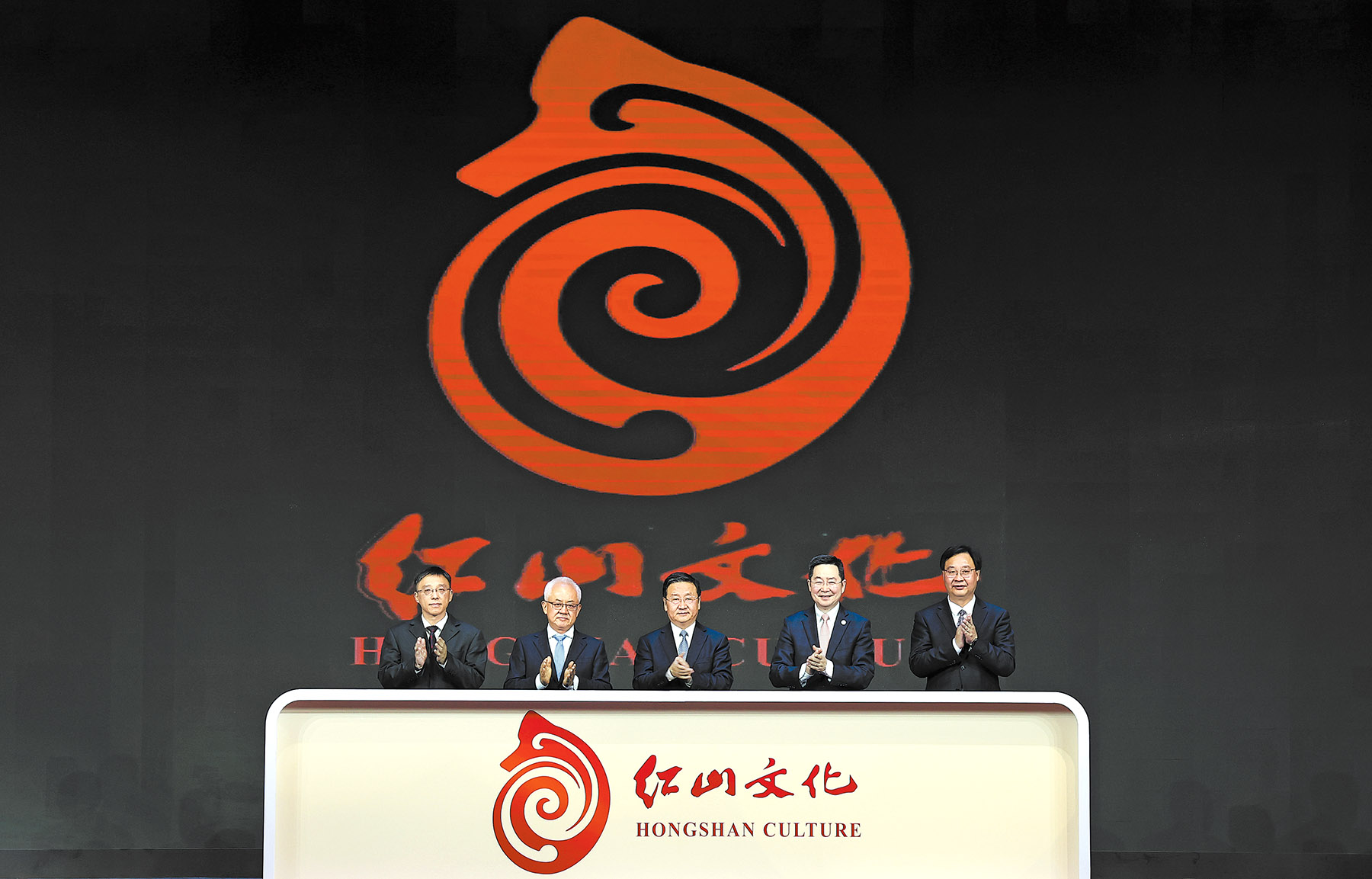
Editor’s note: The International Communication Conference on Hongshan Culture and Vision China event was held in Chaoyang, Liaoning province, on June 14. Under the theme, “Tracing the Origins of Chinese Civilization: Focus on Hongshan Culture”, it brought together professionals in archaeological studies, cultural relics protection and civilization research to share insights into Hongshan culture, which thrived more than 5,000 years ago.
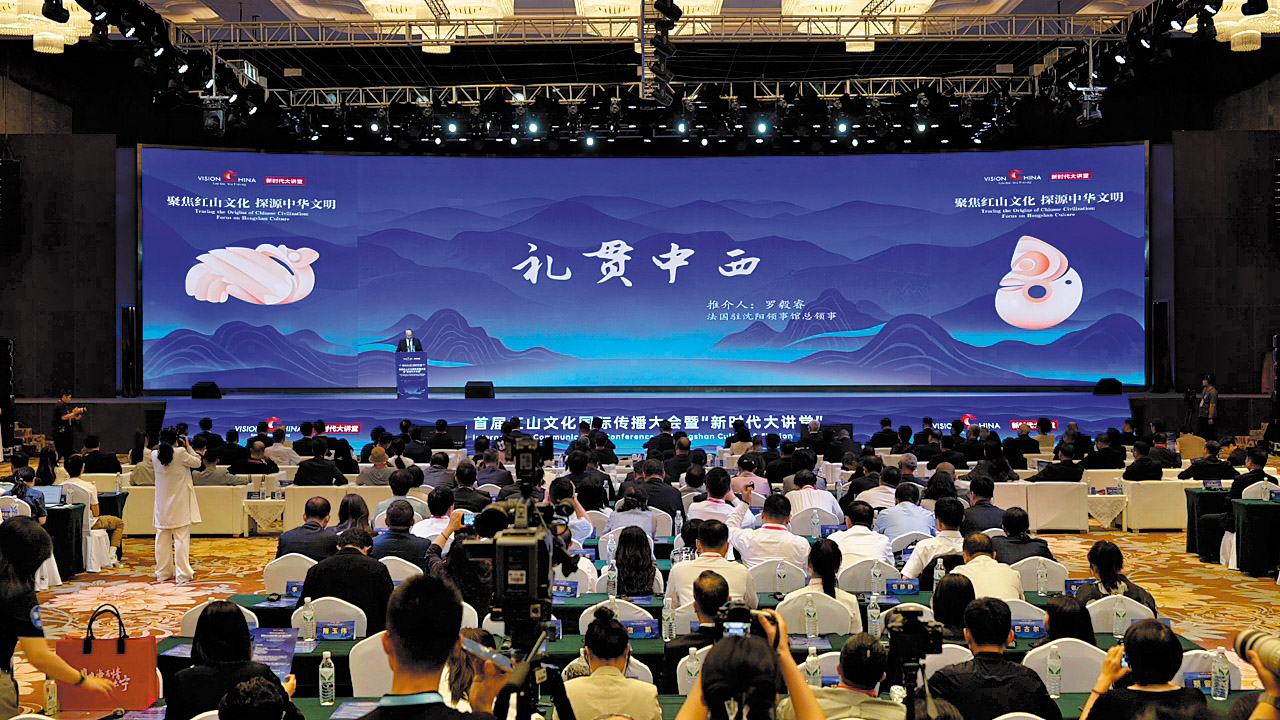
Event hails Hongshan heritage
Cultural heritage serves as a window into the traditions, culture, and even the civilization of a country, so it is essential to intensify research efforts to enhance understanding of China’s cultural ethos and to promote mutual learning among Chinese and foreign civilizations, according to guests at a key cultural event.
They made the remarks at the International Communication Conference on Hongshan Culture and Vision China event on June 14, in Chaoyang, Liaoning province.
Wang Xinwei, governor of Liaoning, said the province will take a series of measures to better protect, inherit and develop Hongshan culture, so that the precious cultural heritage can shine more brightly in the new era.
Hongshan culture, a key Neolithic culture dating from 6,500 to 5,000 years ago, spanned what is today’s Liaoning and Hebei provinces and the Inner Mongolia autonomous region.
Under the theme “Tracing the Origins of Chinese Civilization: Focus on Hongshan Culture”, the event brought together professionals in archaeological studies, cultural relics protection and civilization research, among others, to share their insights on Hongshan culture.
Qu Yingpu, publisher and editor-in-chief of China Daily, said: “The West Liaohe River Basin, together with the Yellow River and Yangtze River basins, is one of the important cradles of Chinese civilization. Among the many shining stars of early Chinese cultures, Hongshan stands out for its brilliance.”
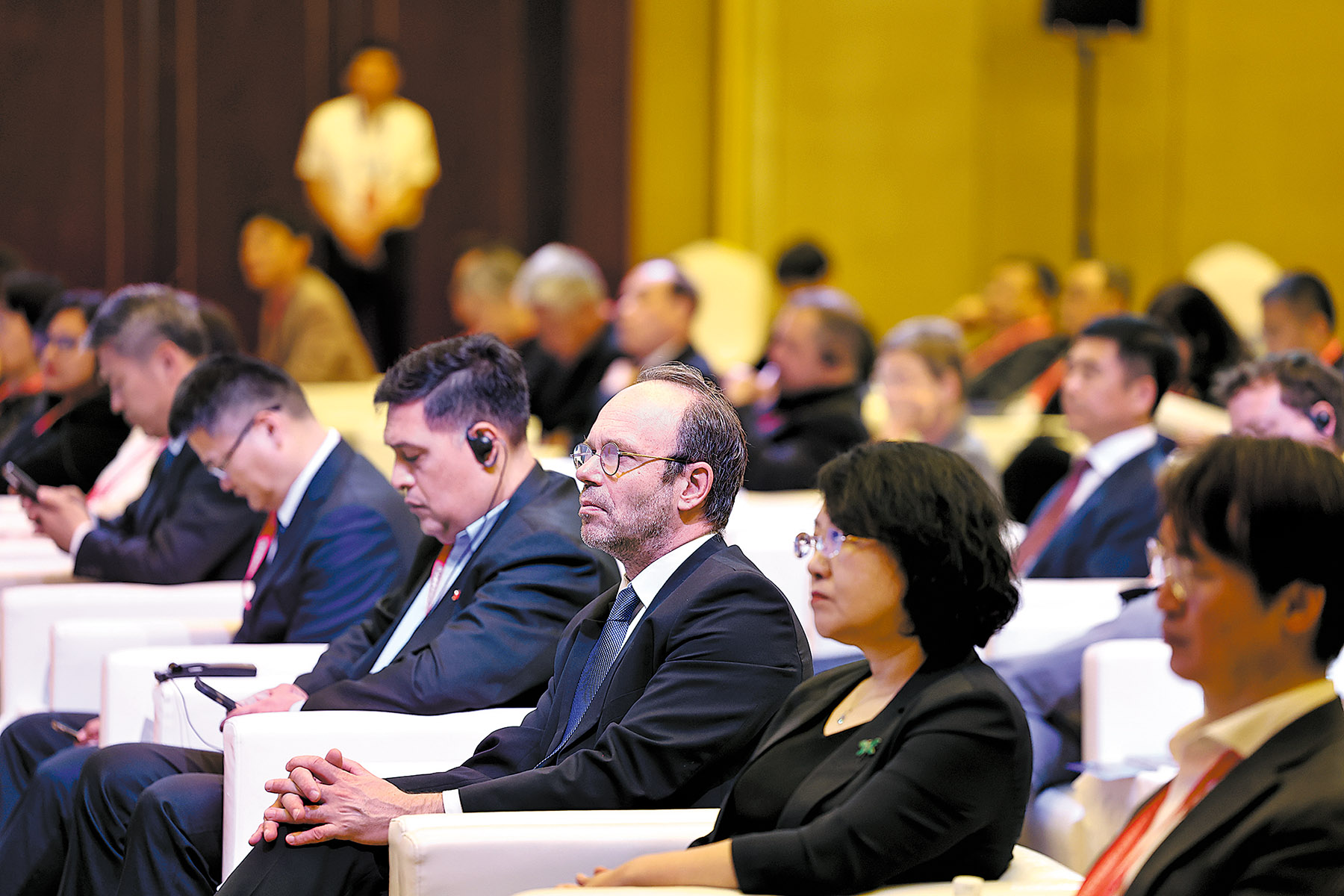
Bao Xianhua, head of the Publicity Department of the Communist Party of China Inner Mongolia Autonomous Regional Committee, highlighted the cooperation between Liaoning and Inner Mongolia to deepen the understanding of Hongshan culture.
Qiao Yunfei, deputy director of the National Cultural Heritage Administration, called for continued efforts to explore the pivotal role of Hongshan culture in the origins and development of Chinese civilization, open museums and archaeological-site parks related to it, and build Hongshan culture into a symbol of Chinese civilization with global influence.
The conference released the official logo for Hongshan culture. Incorporating elements from Hongshan’s painted pottery, the logo features an interlocking double “C “pattern — with one “C” representing “China” and the other representing “culture” — to create a spiraling structure, symbolizing the enduring legacy of Hongshan culture as one of the origins of Chinese civilization.
Highlighting Hongshan’s cultural connections beyond China, Guo Dashun, honorary director of the Liaoning Provincial Institute of Cultural Relics and Archaeology, noted that Hongshan’s painted pottery features three patterns: roses from China’s Central Plains, dragon motifs native to Hongshan, and geometric patterns, such as diamond grids, from Central Asia.
“These designs represent sparks from the fusion of Eurasian cultures, suggesting that about 5,000 or 6,000 years ago a pottery road existed, running south to north and west to east, with the West Liaohe River Basin serving as a melting pot for both West and East Asian cultures,” said Guo.
Elizabeth Childs-Johnson, a US sinologist specializing in Chinese art and archaeology, listed highlights of Hongshan culture and pointed out that Hongshan was one of the earliest cultures to use jade as a symbol of power and wealth.
Jiang Bo, a professor at Shandong University’s Institute of Cultural Heritage and former vice-president of the International Council on Monuments and Sites, said that Hongshan culture, with its stone structures at archaeological sites, jade dragons as the cultural symbol of traditional China, and statues and sculptures that reflect early-period belief systems, has the potential to gain World Heritage status.
Dennis Schilling, a professor of philosophy at Renmin University of China in Beijing, said that Hongshan culture is an important part of the “world heritage of humanity”.
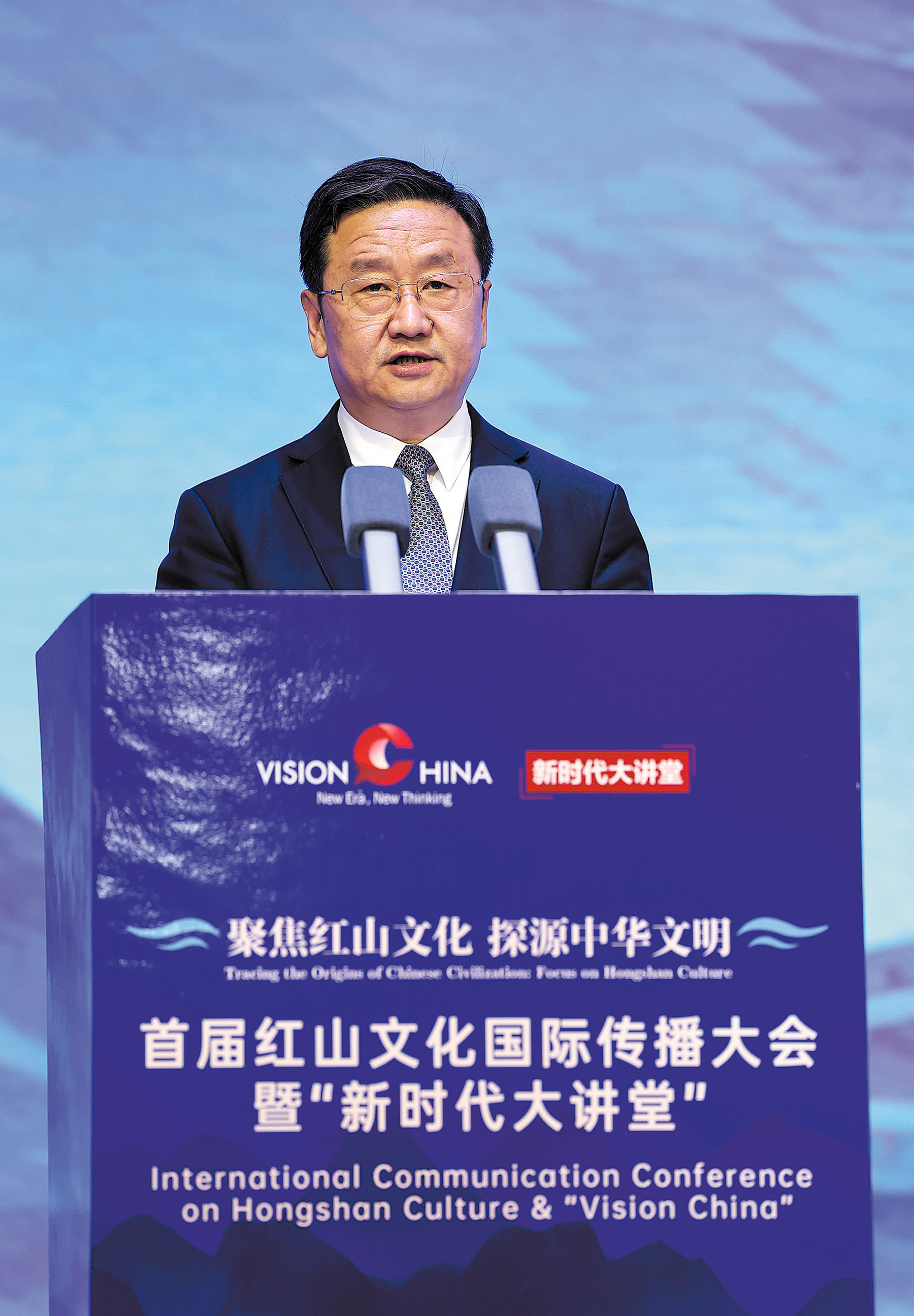
Cradle of China’s dragon identity
Dating back 5,000 to 5,800 years, the Niuheliang site in Chaoyang, Liaoning province, marks a representative late-Neolithic relic site of Hongshan culture in northeastern China.
“Liaoning has nurtured a splendid historical heritage, rich ‘red’ (revolution-themed) culture, robust industrial traditions, and vibrant ethnic cultures,” Wang Xinwei, governor of Liaoning province, said in his speech at the International Communication Conference on Hongshan Culture and Vision China event in Chaoyang on June 14.
“Together, they compose a splendid chapter in Chinese civilization. The Niuheliang site shines like a brilliant star in the sky.”
He said that the meticulously arranged altar, the goddess temple, and rubble mound tombs at the site demonstrate an early practice of polity through rituals, where jade artifacts indicated social hierarchies.
He said the symbolism embedded in its artifacts directly influenced the rituals of the Shang Dynasty (c. 16th century-11th century BC) and Zhou Dynasty (c. 11th century-256 BC), laying a cornerstone of Chinese civilization’s ritualism.
“The Niuheliang site gave birth to the genes of China’s dragon motifs and jade culture. The ‘pig dragons’ (known for their chubby, pig-headed shape and raised ears) unearthed at the site demonstrated the evolution of animal images into the embryonic forms of dragon motifs.”
Chinese people refer to themselves as “descendants of the dragon”, while “gentlemen compare virtue to jade” is an important concept in traditional Confucian thought. Wang said he believed the “pig dragons” unearthed from the site are the spiritual wellspring of such ideas.
“The architectural layouts, exquisite jade and painted pottery items unearthed at the Niuheliang site showcase both the distinctive characteristics of Hongshan culture and integrated elements of Central China Plains civilizations. They vividly demonstrate that China’s over 5,000-year civilization with its diverse elements formed a unity,” he said.
According to the Liaoning Provincial Department of Culture and Tourism, the province received about 652 million visits in 2024, an annual increase of over 28 percent.
The Niuheliang site museum and national archaeological site park also stand as pivotal tourist attractions in Chaoyang.
According to Wang, the province will remain committed to building high-quality demonstration zones for integrated development of culture, sports, and tourism, shoulder the cultural responsibilities in the new era with greater dedication, and advance the study of Hongshan culture.
He expressed hope that experts and guests engage in extensive exchanges and discussions, sharing valuable insights to work together in preserving Hongshan culture.
“Together, we will ensure this precious heritage radiates new splendor in the new era,” he said.
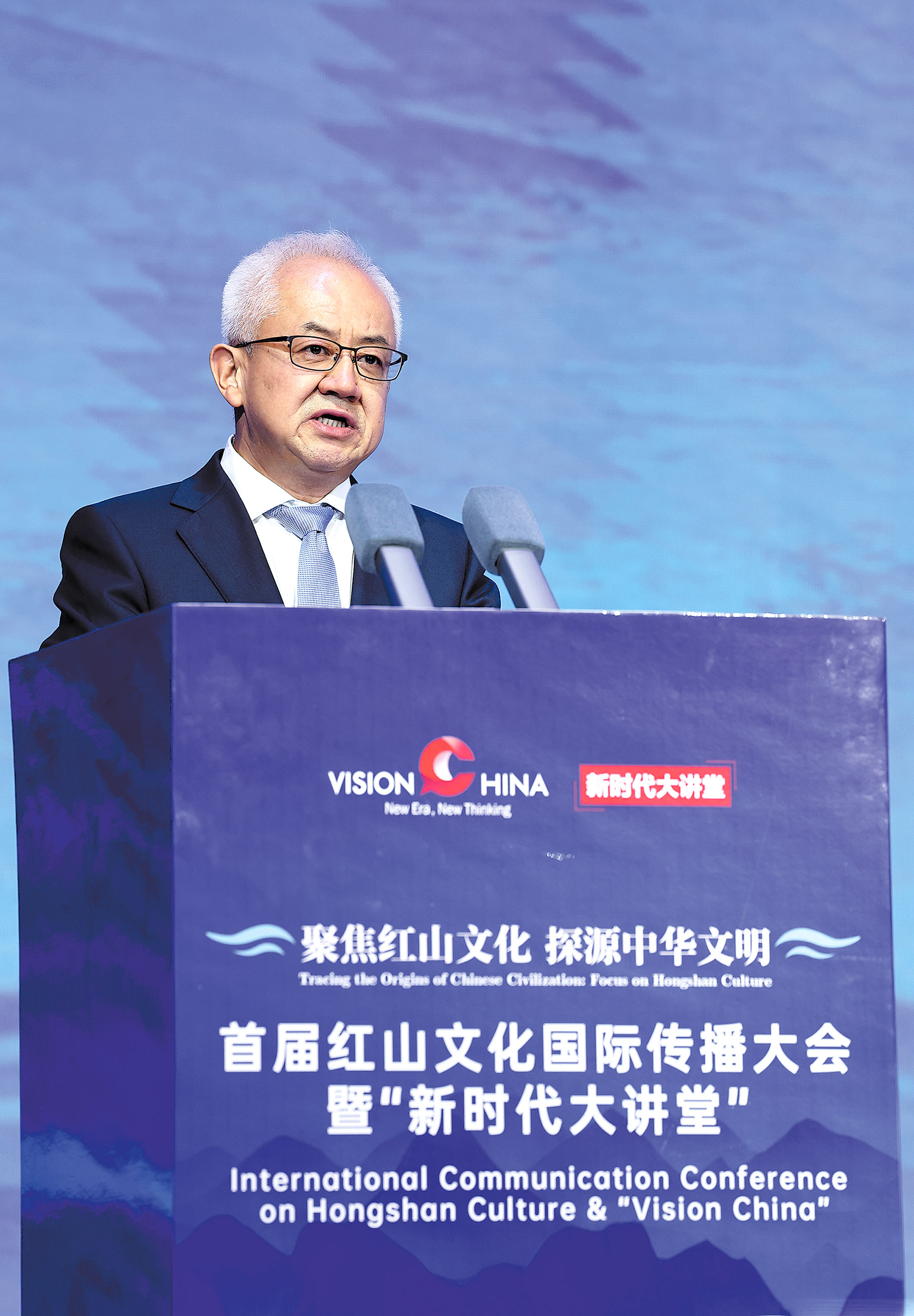
Ancient altars to modern museums
Hongshan culture’s jade ritual artifacts, large-scale sacrificial sites and complex social belief systems make it a cornerstone of late-Neolithic archaeology in northeastern China and an indispensable part of discussions on the origins of Chinese civilization.
Recognizing its key role and ongoing preservation efforts, Qiao Yunfei, deputy head of the National Cultural Heritage Administration, offered suggestions regarding its protection and promotion in his speech at the International Communication Conference on Hongshan Culture and Vision China event held in Chaoyang, Liaoning province, on June 14.
“Archaeological research on Hongshan culture has been in sync with the development of Chinese archaeology over the past century, continuously contributing to the construction of archaeology with Chinese characteristics, style and ethos,” Qiao said.
He acknowledged the efforts made by the regional governments of Liaoning province and the Inner Mongolia autonomous region to safeguard cultural heritage, saying that by strengthening preservation efforts, they have been infusing Hongshan culture with contemporary vitality, as well as injecting lasting energy into local cultural development.
During the 14th Five-Year Plan period (2021-25), the National Cultural Heritage Administration has included research on Hongshan culture in key national initiatives, such as the “Archaeology China” program and a project to trace the origins of Chinese civilization. The administration also supported the construction and opening of the Niuheliang National Archaeological Site Park. Niuheliang is a key site of Hongshan culture in Liaoning.
In order to advance the research, protection and engagement of Hongshan culture, Qiao put forward several suggestions in the aspects of theoretical innovation, preservation and public display, and cultural promotion.
He called for integrated efforts that combine field archaeology, interdisciplinary collaboration and theoretical research to reveal the unique role Hongshan culture plays in the origins and development of Chinese civilization.
Meanwhile, cultural heritage should be allowed public access in accordance with relevant laws and scientific principles. Museums and archaeological site parks should be built and opened to the public, which will enhance cultural confidence and sense of identity.
“Efforts should be made to effectively transform and use archaeological findings, enrich the supply of cultural products and interpret the contemporary value and significance of Hongshan culture through multiple channels, diverse models and comprehensive perspectives,” Qiao said.
“At the same time, it is important to actively build an international communication framework for Hongshan culture, to tell its story to the world and to establish it as a distinctive symbol of Chinese civilization with strong global reach, influence and impact.”
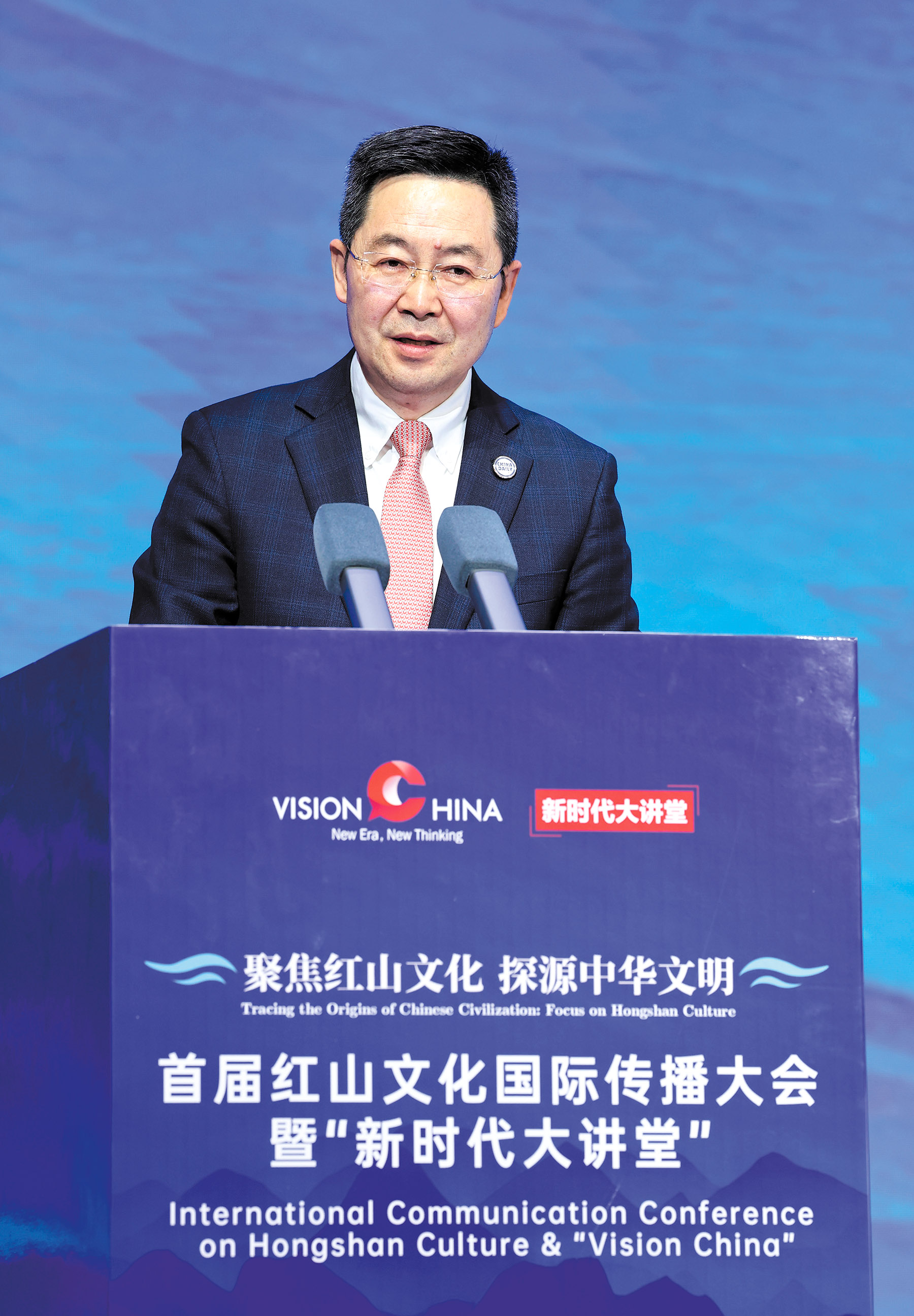
Celebrating spirit of Chinese civilization
Chinese civilization with its long history and profound depth will become increasingly visible, audible and tangible to global audiences, Qu Yingpu, publisher and editor-in-chief of China Daily, said at the International Communication Conference on Hongshan Culture and Vision China event held on June 14 in Chaoyang, Northeast China’s Liaoning province.
Themed “Tracing the Origins of Chinese Civilization: Focus on Hongshan Culture”, the event explored one of the earliest known Chinese cultures and its role in shaping the country’s cultural and spiritual heritage.
Qu noted that efforts to trace the origins of civilizations have deepened public understanding of both human cultural development and the distinctive characteristics of Chinese civilization.
“In the process of tracing our roots, we are expanding our knowledge of human cultural history and gaining a deeper understanding of the spiritual essence of Chinese civilization,” he said.
Highlighting the importance of cultural diversity in today’s world, Qu said that virtually every country and region, and thousands of ethnicities, have contributed to a rich mosaic of civilizations. This diversity is a shared treasure of humanity, and it is our collective responsibility to protect, promote, and pass it on.
He emphasized that the Chinese nation has long drawn strength from adversity and continually renewed itself through exchanges and mutual learning with other civilizations.
Citing Hongshan culture as a prime example, Qu said the Neolithic culture is widely recognized for its sophisticated jade craftsmanship, early religious and ritual sites, and advanced pottery techniques.
He explained that many key elements of Chinese civilization — such as reverence for dragons, the cultural significance of jade and the traditional practices of worshiping heaven, honoring the earth and respecting ancestors — can all be found in Hongshan culture.
“The West Liaohe River basin, together with the Yellow and Yangtze river basins, is one of the important cradles of Chinese civilization,” he said. “Among the many shining stars of early Chinese cultures, Hongshan stands out for its brilliance.”
He added that core values derived from this ancient culture — such as the worldview of harmony between humanity and nature, the Confucian ideal of being “as gentle as jade”, and a spirit of openness and inclusiveness — remain central to Chinese society today.
Qu also underscored the significance of the Niuheliang archaeological site in Chaoyang, a representative site of Hongshan culture. “Niuheliang is not only a geographical landmark but also a cultural symbol — a place where the waters of life flow, and cultural connections converge,” he said.
Looking ahead, Qu called for expanded research and deeper interpretation of Hongshan culture, with the aim of transforming the wisdom and values embedded in traditional Chinese culture into a language that resonates globally.
“We must build a recognizable system of Chinese cultural symbols to help the world better understand China and the spiritual world of the Chinese people,” he said.
He also advocated for the use of modern technologies to bring ancient stories to life.
“Unraveling the mysteries of ancient civilizations requires collaboration among scholars and the support of emerging technologies,” he said.
“We should harness tools like artificial intelligence to tell our ancestors’ stories in vivid, contemporary and engaging ways, making ancient culture visible, audible and tangible. Let the treasures of Hongshan culture and other fine elements of traditional Chinese culture shine at the fingertips of global audiences.”
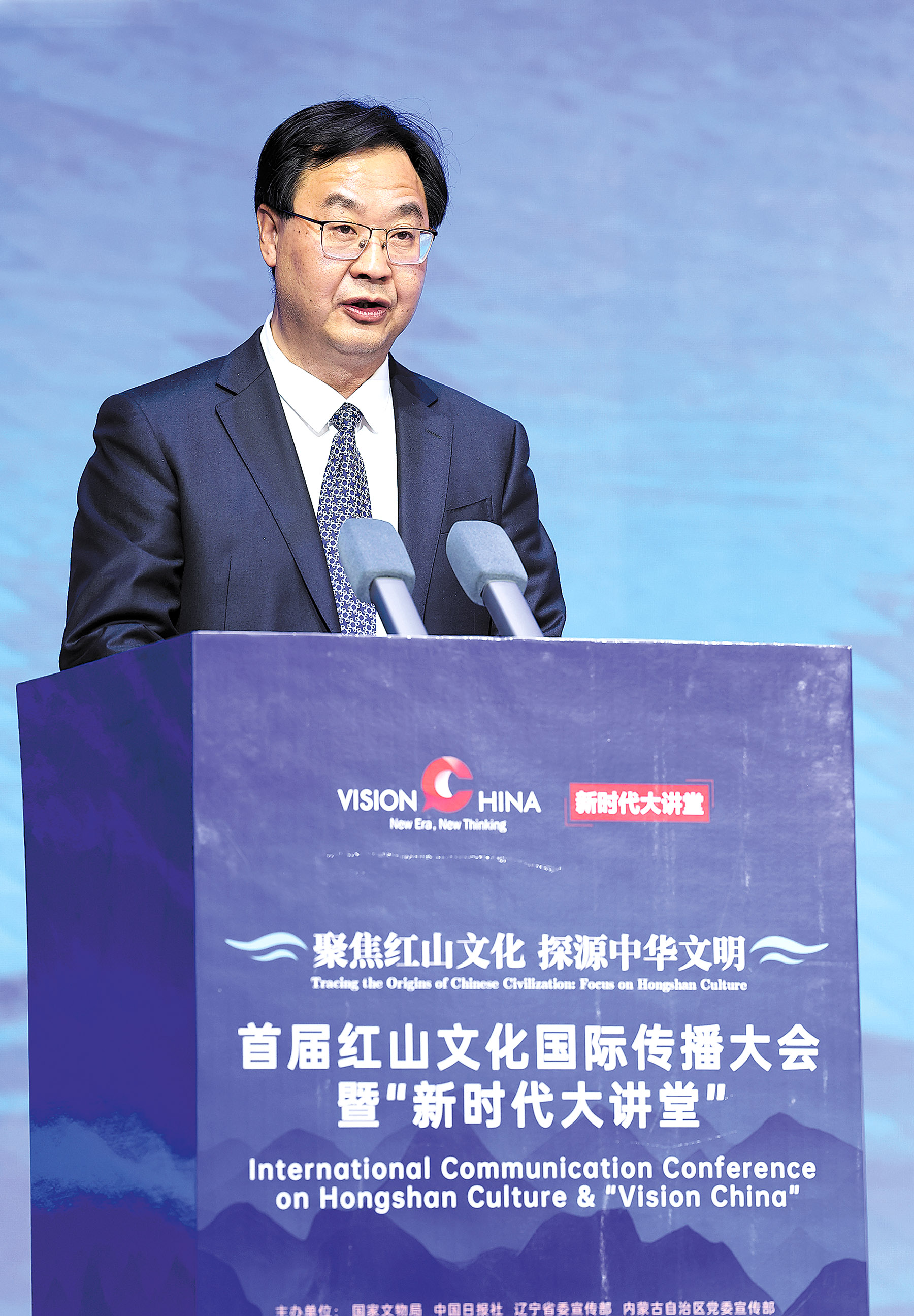
Creating cultural continuity across time
Our understanding of Neolithic Hongshan culture has continued to grow, as 39 archaeological sites have been discovered in recent years following a series of excavations in the Inner Mongolia autonomous region in North China, said Bao Xianhua, head of the Publicity Department of the Communist Party of China Inner Mongolia Autonomous Regional Committee.
Bao shared this progress, as part of the “Archaeology China” project, at the International Communication Conference on Hongshan Culture and Vision China event, held on June 14 in Chaoyang, Liaoning province. Attendees marked accomplishments in the research of Hongshan culture and its significance for tracing the origins of Chinese civilization.
Liaoning and Inner Mongolia are both hubs of Hongshan, where archaeological digs have been updating awareness of this culture that emerged around 6,500 years ago.
It takes its name from the crucial discoveries at the Hongshanhou archaeological site in Chifeng, Inner Mongolia, first made in 1935.
Bao said Inner Mongolia and Liaoning have worked shoulder-to-shoulder over the years to yield achievements in joint excavations and academic research of Hongshan culture, as well as its protection.
He added that Inner Mongolia has collaborated closely with Liaoning to enact regulations protecting Hongshan sites and artifacts, and carried out archaeological investigations in the drainage basin of the Xar Moron River and Laoha River, two hubs where Hongshan culture once thrived, under the “Archaeology China” program.
“The survey was conducted at 574 ruins,” Bao said.
“The findings at the Caitaopo and Yuanbaoshan sites in particular have provided new evidence for the origins of Chinese civilization.”
Bao called Hongshan culture “a living fossil” testifying to the continuity and progress of Chinese civilization, as well as the formation and development of its pluralistic and integrated pattern.
He said he believed that by opening up dialogues on academic and cultural exchanges, the conference would extensively influence the development of Hongshan’s cultural heritage and the promotion of its international profile.


